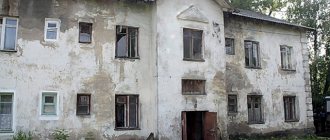Rules for filing a claim for redevelopment of an apartment or house
You can write a claim yourself. Just follow these rules:
- You can file a claim on an A4 sheet. Both printed and handwritten versions are acceptable.
- Stick to a formal business style.
- You can use only one color of ink (either only black or only blue).
- Place the “header” of the document on the right side of the sheet, in its upper part.
- Squeak the name in the middle of the line, after the “header”.
- The title of the document must be capitalized.
- Do not use quotation marks in the title and do not put a period after it.
- Divide the main part into paragraphs. Continuous text is difficult to read.
- Demands to the court can begin with the words “I ask the court...”. You can list your requests in a list.
- Sign and date after the requirements.
- Afterwards you can prepare a list of documents. If you add something to the list, you can simply add the name of the paper at the end.
- Fill out your claim without errors, cross-outs, or blots. Otherwise they won’t accept it and will force you to rewrite it.
Please note that the claim must be drawn up in several copies , in accordance with the number of participants in the process. That is, the plaintiff must submit one claim to the court, the second - to the defendant, and the third - to keep for himself as confirmation of its acceptance by the authorities.
If there are third parties in the case, then a version of the statement should be prepared for them as well.
Unauthorized reconstruction
Redevelopment of residential premises without the appropriate permission obtained from the relevant authorities is called unauthorized reconstruction.
The following types of construction and installation work fall under this concept:
- moving interior walls;
- violation of the integrity of load-bearing structures (displacement of walls);
- installation of interior partitions;
- dismantling of ventilation shafts, with subsequent disruption of communication;
- creation of decorative arches and openings;
- reconstruction of utilities, etc.
In accordance with the norms of legislation in force in the Russian Federation, owners of urban real estate who have unauthorizedly carried out redevelopment in them may be punished.
After ignoring the demands of representatives of the law to bring the apartment to its previous technical condition, their housing is legally subject to confiscation if they do not resolve issues related to legalization in court.
It is also worth noting that unauthorized redevelopment of residential premises is subject to financial penalties in the form of a fine, the amount of which, based on Article 7.21 of the Code of Administrative Offenses of the Russian Federation, varies from 2000 to 2500 rubles.
Don’t know where to get a technical opinion on the possibility of remodeling an apartment? See here.
How to legitimize?
If the owner of a city apartment does not want to comply with the requirements of local authorities to bring the property to its original condition, he can initiate a legalization procedure in court.
Article 29 of the Housing Code in force on the territory of the Russian Federation provides for situations in which converted residential premises can be used even with unauthorized redevelopment.
If the changes made did not affect the interests of other residents of the apartment building, and also did not affect its strength, unauthorized redevelopment can be legalized through the court.
Sample and example of a claim to court for legalization of redevelopment
Samples of a statement of claim to preserve the premises in a redesigned form without the approval of a government agency:
Sample 1:
Sample 2:
A ready-made claim form for apartment redevelopment is available free of charge.
A ready-made form for a statement of claim for the preservation of residential premises in a rebuilt and (or) redesigned state, the redevelopment and (or) redevelopment of which was carried out without permission, is available free of charge
Let's legalize the redevelopment
As follows from the evidence presented, as a result of redevelopment and reconstruction in the apartment we own, the bathroom area decreased by 0.9 sq.m. and is currently 2.5 sq.m. (previously it was 3.4 sq.m.); The corridor area decreased by 1.2 sq.m. (previously it was 3.6 sq.m., currently - 2.4 sq.m.). By reducing the area of the bathroom and corridor, a kitchen was created - a niche with a sink and household appliances; the kitchen niche is not separated from the living room; Thus, as a result of redevelopment and reconstruction, the area of the living room also increased by 1.7 sq.m. (previously it was 8.7 sq.m., currently it is 10.4 sq.m.). The total area of the apartment decreased by 0.4 sq.m. (from 15.7 sq.m. to 15.3 sq.m.).
We recommend reading: Tax Refund When Buying an Apartment Refund Period
Redevelopment and reconstruction were carried out in the apartment without proper permission, which is confirmed by information from the Novosibirsk branch of the Federal State Unitary Enterprise "Rostekhinventarizatsiya - Federal Bureau of BTI", the technical passport of the premises and the conclusion of OJSC "Novosibirsk Promstroyproekt", attached to this statement of claim.
Registration procedure
- Collection of necessary documentation.
- Purchasing a project from a specialized company that has a license for this.
- Providing a complete package of documents to the BTI along with an application in the established form.
- Choosing the time to visit a BTI representative.
- Analysis of real estate for redevelopment, drawing up an approval report by BTI representatives.
- Carrying out repair work.
- Submitting an application to the BTI at the end of the work process.
- Visit of a specialist to check compliance.
- Issuance of technical passport.
- If the area of the property changes, contact the Housing Commission.
- Obtaining a new certificate of ownership.
Where to contact{q}
If this is an apartment, then it will be enough to contact the BTI, and then the Housing Commission. If this is a private home or office space, then you need to call the employees of the Ministry of Emergency Situations and the SES.
They will draw up an act of compliance with fire and sanitary standards and only then you need to contact the BTI and the Housing Commission.
- title certificate;
- technical certificate;
- identification document of the applicant;
- design documentation;
- other documents that are required to be provided in a specific region.
Here is a sample application for redevelopment,
sample technical passport,
The current legislation also establishes the time frame for consideration of the application. You will need to allocate 1 month for approval. And for final registration 3 months.
But in each individual region this period is slightly different. In many cities, approval can already be obtained within 10 working days.
Price
Overall, the average price is:
- purchase of a standard project 15,000 – 30,000 rubles;
- purchase of an individual project – up to 150,000 rubles;
- approval – 30,000 rubles;
- for each document 2,000 rubles.
Next comes an appeal to the court. In agreement with the BTI, this is done either by the administration or by the apartment owner himself.
In any case, you will need the following documents:
- owner's passport;
- certificate for the apartment;
- the agreement on the basis of which the right to the apartment was obtained;
- the old technical passport of the apartment and the new one ordered from the BTI;
- cadastral passport;
- all permits received;
- project;
- statement of claim;
- receipt of payment of state duty (1000 rubles).
How to legalize redevelopment through the court{q}
Stages of registration
If changes have been made to the house that are permitted by law, then it is still possible to formalize them even after the repairs are completed.
The regulations for this procedure are contained in Articles 25 and 29 of the RF Housing Code. To legitimize, the following procedure should be followed.
Contact the territorial department of the BTI with a statement that you have carried out any work in the house without the consent of the relevant authorities. Along with the application you will need to present the following documents:
- registration certificate and floor plan of the apartment;
- certificate of ownership;
- passport.
A BTI engineer will take measurements of your living space and draw up a new floor plan. On its basis, a new document will be issued for your apartment, which will reflect in the form of red lines all the changes that you have made.
Having this document in hand, you should contact the organization responsible for coordinating such issues in your city (Housing Inspectorate, Architectural Department, Capital Construction Department, etc.).
We invite you to read: The lease agreement was terminated without a transfer acceptance certificate
After receiving permission, order a work project.
The production of projects is carried out by specialized companies with SRO approval.
If the changes are not significant, it is possible to design according to your own sketch.
In fact, it is possible to apply the same lines on a copy of the old plan that the BTI technician made. The services of many design organizations also include approval of the project in the relevant authorities.
By ordering such a service, you can save yourself from having to spend a long time knocking around doorsteps. Moreover, in this case, the designers will eliminate all shortcomings in the document at their own expense.
The finished project is subject to approval by various authorities:
- Rospotrebnadzor (SES).
- Rostekhnadzor.
- Fire safety service.
- Architectural and planning department of local governments
- Gas service.
- Other organizations at the request of the Housing Inspectorate.
In each of these authorities you must be given an official technical report with the seal and signature of the manager. The conclusion is issued after studying the plan, but in some cases it may be necessary to visit your home by specialists from these organizations.
After receiving all permits, you should again contact the organization that coordinates such work in your city. In addition to the application, employees are presented with a package of documents:
- title documents;
- consent to this work from all owners (if the housing is in shared ownership);
- consent of residents of neighboring apartments, including neighbors above and below;
- technical passport and floor plan;
- project or sketch;
- agreement with the organization that prepared the project;
- permissions of all controlling structures (the list is listed earlier);
- technical safety report.
If any of the documents is not presented, the administration may refuse approval.
The administration will review the package of submitted documents within 30-45 days, after which, if the decision is positive, you will receive an acceptance committee act and permission to put the housing into operation.
Having these papers in hand, you need to contact the BTI again to draw up a new floor plan for the apartment and issue a Technical Passport.
If the changes to the living space are significant and capital, you must contact Rosreestr to issue a new Certificate of Ownership and a cadastral passport of the property. The following documents are submitted to Rosreestr:
- certificate of ownership (old);
- floor plan from BTI;
- cadastral passport of the object;
- owner's passport;
- act of the acceptance committee.
For unauthorized reconstruction, you will have to pay a fine of 2-2.5 thousand rubles, regardless of whether you receive permission in the future or not.
If changes have been made to the house that are permitted by law, then it is still possible to formalize them even after the repairs are completed.
Refusal to satisfy the claim
After the redevelopment, the owners of city apartments need to apply to the court to legitimize all reconstructions.
At the court hearing, representatives of Themis carefully study the documents provided by the applicant, after which they pronounce a verdict.
Despite the large number of collected permits, owners of redeveloped real estate cannot always count on a positive decision from the judge.
Federal Russian legislation defines the following cases that will constitute an insurmountable obstacle to the legalization of reorganization (based on Article 27 of the RF Housing Code):
- gas pipes and heating appliances were moved without permission;
- ventilation was damaged during the redevelopment process;
- the area of the kitchen or bathroom has been increased at the expense of living quarters;
- boxes intended for various utilities have been disassembled or damaged.
Conditions for legalization
The state does not care how and what you remodel in the apartment, the plan of which the state previously approved. Redevelopment affects not only the comfort of the residents of a particular apartment, but also the safety of neighbors and even the entire house.
If the redevelopment has already been done, there are two ways to legalize it.
We invite you to read: Reimbursement of costs for power outages
Administrative. You need to collect documents and submit an application to the authority that deals with such issues. In Moscow this is the Moszhilinspektsiya. You can check with your local BTI.
Judicial. If the department refuses, file a lawsuit to declare the decision to refuse illegal. The court may order an examination.
Before submitting claims to the court, you should prepare documentation that will confirm that the redevelopment can be saved without returning to its previous state. You can obtain the relevant documents from Rospotrebnadzor, as well as Gospozhnadzor, which have the right to conduct expert studies and give opinions.
The defendant in such cases is the local government body dealing with housing issues. Third parties are citizens living in this living space. The claim for redevelopment of the apartment is considered by the district (city) court.
- Article 26 and Article 25 of the Housing Code of Russia;
- Article 7.21 and Article 7.22 of the Code of Administrative Offenses of the Russian Federation.
Here are the basic concepts and features of the procedure. It also stipulates the possibility of filing an appeal in court if registration is refused.
The latest legal act talks about penalties for illegal redevelopment.
Illegal redevelopment does not always occur due to the malicious intent of the owners. For example, the owners of the premises simply did not know that some design changes in the apartment must be approved by the competent authorities. Some people inherit or donate living space that has already been remodeled.
Dear readers! Our articles talk about typical ways to resolve legal issues, but each case is unique.
Be that as it may, if the changes made are not legalized, then it will be impossible to dispose of the apartment, since its actual design does not coincide with the plan indicated in the cadastral passport.
Unauthorized redevelopment of an apartment: how to legalize it and what is the responsibility for such actions {q} The answer is contained in our new publication.
- demolish load-bearing walls or weaken them by cutting through arches or windows;
- move or expand doorways in load-bearing walls (at the same time, it is allowed to reduce the openings);
- move the bathroom or toilet to the place where the neighbors below have living quarters or a kitchen;
- add square meters to the bathroom, kitchen or balcony at the expense of living rooms (at the expense of the corridor - you can);
- combine the kitchen and the room using an arch or doorway, if there is a gas stove in the kitchen (if it’s electric, it’s possible);
- make heated floors in the bathroom or toilet through the use of a common plumbing system.
- moving doorways in ordinary, non-load-bearing walls;
- relocation of window openings;
- changing the area of living rooms, kitchen or bathroom due to the corridor;
- dismantling or creating storage rooms;
- moving a bathroom or toilet, including moving only a toilet, bathtub or shower;
- moving or dismantling radiators.
The conditions are described in more detail in Chapter 4 of the Housing Code, which is entirely devoted to the reconstruction of apartments.
Thus, before starting to legalize redevelopment, you need to make sure that it does not violate the rules.
- a package of documents required for redevelopment is collected;
- a simple sketch of the reconstruction is drawn up, on which demolished areas are marked directly on the plan with red paste, and built ones with green paste;
- the drawn up sketch is presented to the sanitary and epidemiological station and the department of the Ministry of Emergency Situations, a permit is issued on their behalf;
- the owner of the apartment submits an application to the architecture department for permission to carry out redevelopment, attaches certificates from the SES and fire supervision;
- after receiving permission, 2-3 months pass, supposedly during this time repairs are carried out;
- an interdepartmental commission is called in to evaluate the quality of the repair and its compliance with the stated sketch;
- if everything is in order, a certificate is issued;
- using an act from the BTI, a new technical passport is ordered;
- After registration of the technical passport, you need to issue a new certificate of ownership of the apartment.
Thus, such an action plan is no different from the standard procedure when repairs have not yet been made. This will help you avoid wasting money, time and nerves.
Unauthorized redevelopment of an apartment: how to legalize{q}
- a BTI engineer may want to look at the apartment BEFORE the redevelopment - and since it has already been done, it turns out that the owner of the living space violated the law twice: he illegally rebuilt the home and tried to deceive government officials;
- the sketch may not be approved by the SES or the Ministry of Emergency Situations, and everything will have to be redone, in addition, a service specialist may also want to look at the apartment BEFORE the renovation;
- the plan may not receive support from the architecture department if it violates some urban planning regulations;
- If the design changes are serious, the apartment owner can’t get away with a sketch - he’ll have to order a project, which is much more expensive and requires a preliminary inspection of the apartment by specialists.











